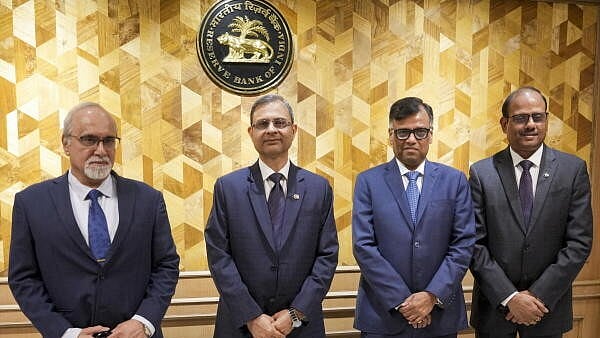
Reserve Bank of India (RBI) Governor Sanjay Malhotra along with Deputy Governors M. Rajeshwar Rao, Swaminathan Janakiraman and T. Rabi Sankar arrives for a press conference on Monetary Policy Statement, at RBI headquarters in Mumbai.
Credit: PTI Photo
New Delhi: The Reserve Bank of India (RBI) on Friday said India’s GDP growth is likely to be 6.7 per cent in 2025-26, which is slightly higher than its revised estimate of 6.6 per cent for the current financial year, while inflation is projected to ease by 60 basis points to 4.2 per cent.
Delivering his first monetary policy statement as RBI Governor, Sanjay Malhotra said the economic activity is expected to improve in 2025-26, with the manufacturing sector likely to pick up in the second quarter.
“Early corporate results for Q3 indicate a mild recovery in the manufacturing sector. Mining and electricity are rebounding from monsoon related disruptions in Q2,” Malhotra said.
In the December meeting, the RBI’s Monetary Policy Committee (MPC) had decided to lower the current financial year’s growth projection from 7.2% to 6.6%. The MPC’s cut in GDP growth projection followed a worse-than-expected Q2 numbers. India’s gross domestic product (GDP) growth slumped to 5.4% in July-September 2024 period, the lowest in seven quarters.
In early January, the National Statistical Office (NSO) in its first advance estimate, pegged the GDP growth projection for the current financial year to 6.4%, sharply lower than 8.2% expansion recorded in the previous year. The growth projection for the current year is the lowest in four years.
As per the RBI, the GDP growth is projected to remain at 6.7% in the first quarter of 2025-26. It is expected to accelerate to 7% in July-September 2025 period largely due to low base. For Q3 and Q4 of 2025-26 the RBI has pegged the GDP growth at 6.5%.
“Elevated rates have impacted India’s GDP growth this fiscal. The Budget for next fiscal is mildly supportive for growth, while continuing on the fiscal consolidation path,” said Dharmakirti Joshi, Chief Economist at CRISIL In its last bi-monthly review of the current financial year, the RBI monetary policy committee decided to cut policy interest rate by 25 basis points or 0.25% to 6.25%.
The central bank expects the headline inflation to ease to 4.2% in 2025-26 from the projected 4.8% in the current financial year. In April-June 2025 period Consumer Price Index (CPI) inflation is projected at 4.5%. It is expected to come in the RBI’s medium-term target of 4% in the second quarter of FY26 and ease further to 3.8% in Q3. However, in the fourth quarter of 2025-26 the headline retail inflation is projected to accelerate to 4.2%.
“Headline inflation, after moving above the upper tolerance band in October, has since registered a sequential moderation in November and December,” said Malhotra.
CPI retail inflation declined to a four-month low of 5.22% in December from 5.48% recorded in the previous month. It had surged to a 14-month high of 6.21% in October.
Cut-off box - RBI delays proposed liquidity rules for lenders Bloomberg: The Reserve Bank of India has delayed the implementation of proposed liquidity regulations for lenders that may have hampered their efforts to boost credit. The so-called liquidity coverage ratio norms announced in July won’t be implemented until at least March 2026 central bank Governor Sanjay Malhotra told reporters on Friday. The earlier deadline was April 1 2025. The norms required banks to park a larger portion of their deposits in sovereign bonds as a buffer against sudden withdrawals in the age of digital banking. That would have added to the challenges being faced by lenders amid a cash crunch in the banking system. The move “will positively support the risk appetite of lenders and support credit growth amid a recent slowdown” said Anil Gupta co-group head of financial sector ratings at ICRA Ratings. While proposing the guidelines in July the RBI asked banks to assign an extra 5% run-off rate for retail deposits equipped with Internet and mobile banking facilities. For banks meeting the higher liquidity norms needs would have meant buying government securities of as much as 4 trillion rupees ($46 billion) ratings firm ICRA said earlier.